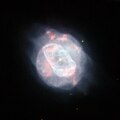ملف:NGC 5882 HST.tif

حجم معاينة JPG لذلك الملف ذي الامتداد TIF: 600 × 600 بكسل. الأبعاد الأخرى: 240 × 240 بكسل | 480 × 480 بكسل | 640 × 640 بكسل.
الملف الأصلي (640 × 640 بكسل حجم الملف: 639 كيلوبايت، نوع MIME: image/tiff)
تاريخ الملف
اضغط على زمن/تاريخ لرؤية الملف كما بدا في هذا الزمن.
| زمن/تاريخ | صورة مصغرة | الأبعاد | مستخدم | تعليق | |
|---|---|---|---|---|---|
| حالي | 12:40، 4 أبريل 2011 |  | 640 × 640 (639 كيلوبايت) | Jmencisom | {{Information |Description ={{en|1=The NASA/ESA Hubble Space Telescope has captured a planetary nebula with unconventional good looks. Planetary nebulae signal the demise of mid-sized stars (up to about eight times the mass of the Sun); when the star� |
استخدام الملف
الصفحة التالية تستخدم هذا الملف:
الاستخدام العالمي للملف
الويكيات الأخرى التالية تستخدم هذا الملف:
- الاستخدام في arz.wiki.x.io
- الاستخدام في el.wiki.x.io
- الاستخدام في en.wiki.x.io
- الاستخدام في es.wiki.x.io
- الاستخدام في fa.wiki.x.io
- الاستخدام في fr.wiki.x.io
- الاستخدام في it.wiki.x.io
- الاستخدام في mk.wiki.x.io
- الاستخدام في ml.wiki.x.io
- الاستخدام في mr.wiki.x.io
- الاستخدام في pl.wiki.x.io
- الاستخدام في pt.wiki.x.io
- الاستخدام في sk.wiki.x.io
- الاستخدام في sl.wiki.x.io
- الاستخدام في sr.wiki.x.io
- الاستخدام في sv.wiki.x.io
- الاستخدام في vi.wiki.x.io